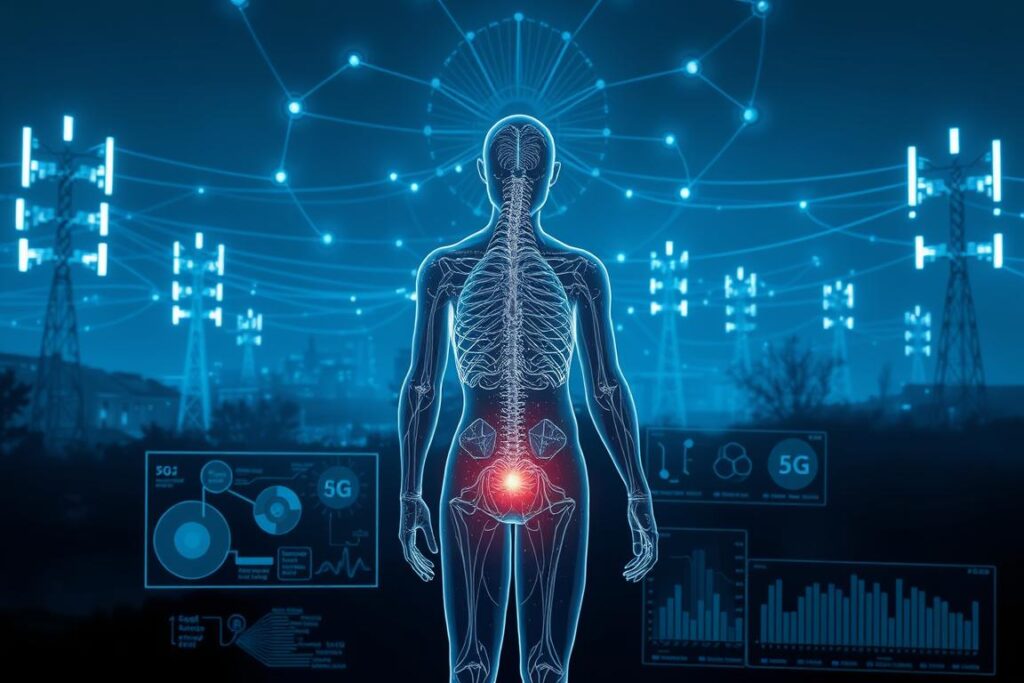5G space appeal: risks and debates
Did you know that an Australian research group found that 68% of 2266 studies analyzed showed significant biological or health effects from anthropogenic electromagnetic fields? This alarming statistic is just one part of the debate surrounding the expansion of 5G technology, which is causing a great deal of discussion worldwide.
With over 50,000 supporters worldwide, the international space appeal against 5G has met with an impressive response. But why has this technology provoked such a strong reaction, particularly in terms of health risks and environmental impact?
The recommended maximum specific absorption rate (SAR) for electromagnetic radiation is 2 watts per kilogram at the head/ear, but critics warn of the significant increase in forced exposure due to the planned expansion of mobile phone sites. With the introduction of 5G, which is expected to transmit up to 1000 times more data than previous generations, not only immense technological advances but also significant health risks and environmental impacts are under scrutiny.
The debate surrounding 5G is complex, touches on various areas and demands answers. This debate will be explored in greater depth in the following sections, where we will examine the health, environmental and social aspects in detail.
Introduction to 5G technology
5G technology marks a significant advance in the mobile industry and is a key driver of digital transformation. With the ability to offer significantly higher speeds and lower latency, this technology opens up a wide range of applications and possibilities that go far beyond what previous generations have made possible.
What is 5G?
5G stands for the fifth generation of mobile technology and promises to fundamentally change the way we are connected. With frequencies mainly in the 3.5 GHz range and planned auctions for the 700 MHz band, 5G enables up to 1 million IoT devices to be connected per square kilometer. The installation of base stations in urban areas is required at a distance of 100 to 150 meters to ensure nationwide coverage.
Technical advances and advantages
The technical advances brought about by 5G include higher data transmission speeds, greater network density and improved reliability. These advances are crucial for supporting applications such as autonomous vehicles, smart cities and remote medical monitoring. At the same time, 5G is expected to more than double the energy consumption of the IT industry, creating new challenges.
5G in the context of digital transformation
5G is a catalyst for digital transformation and is helping various industries to achieve technological progress. The expansion of the 5G mobile network in Europe requires investments of around 500 billion euros and thousands of new transmitters. However, in addition to the networking of Industry 4.0 and the development of new business models, 5G also contributes to the acceleration of climate change due to increased resource consumption and rising energy requirements.
Health risks from 5G: the current state of research
The introduction of 5G technology has triggered an intense debate about potential health risks. The focus is particularly on 5G radiation and its effects on the human body. The electromagnetic fields emitted by 5G networks are the subject of controversy and numerous studies.
Electromagnetic radiation and its effects
5G works with frequencies around 2 GHz and 3.6 GHz, with frequency ranges around 26 GHz being added in the coming years. These frequencies exceed the range of low-frequency radiation and are in the high-frequency range. Electromagnetic fields from high-frequency radiation can have a variety of effects, some of which are still poorly understood.

Studies on carcinogenic effects
Studies have shown that 5G radiation could potentially be carcinogenic. In one study, around 7000 rats and mice were exposed to mobile phone radiation for nine hours a day for their entire lives, which led to increased tumor development in male animals. It should be emphasized that the radiation intensity in the animal experiments was significantly higher than in the everyday human environment.
The Federal Office for Radiation Protection emphasizes that there are no known adverse health effects below the current limits. Nevertheless, 400 doctors and scientists are calling for more comprehensive research into these potential health risks.
Specific risks for children and sensitive population groups
Special care should be taken with children and sensitive population groups, as they are considered to be potentially more at risk. Small cell structures and developing organs may be more sensitive to electromagnetic fields. This calls for specific regulation and clear limits in order to minimize long-term health risks.
In Germany, scientific and public voices are urging caution and further research. Studies show that the bioburden at a distance of 6-7 meters from a 5G antenna is significantly higher than with previous generations of mobile communications.
The 5G Space Appeal: background and demands
The 5G Space Appeal has attracted global attention as it highlights the profound technological and ethical issues surrounding the deployment of 5G. The deployment of this advanced technology raises key questions about technological ethics and the potential health risks associated with increased radiation exposure.
One of the main concerns of the 5G Appeal is the health effects of radio frequency (RF) radiation. Scientific studies show that RF radiation can make particularly sensitive people ill. Over 10,000 peer-reviewed publications support these findings. The 5G Space Appeal is therefore calling for a reassessment of the current safety standards, which have so far only taken into account the thermal effects of radiation.
Technological ethics play a decisive role in the evaluation of the 5G network. Critics point out that the comprehensive introduction of 5G will require up to 800,000 new mobile phone masts in Germany, which will significantly increase radiation exposure. A higher radiation density is expected in urban areas in particular, which could lead to health problems.
Another central concern of the 5G Space Appeal is the use of satellites in space. It is predicted that up to 20,000 new satellites will be stationed for the 5G network. This could multiply RF radiation and have far-reaching environmental and health consequences. Cities such as Rome, Florence and the Swiss cantons of Geneva, Vaud and Jura have already announced a temporary halt to the 5G project.
The demands of the 5G Appeal aim to bring technological ethics to the fore and carry out a holistic assessment of the risks and benefits of 5G. This also includes the protection of particularly sensitive population groups that are already suffering from current radiation exposure.
Overall, the Space Appeal emphasizes the need for extensive research and transparent communication about the potential impact of 5G. Only through an ethically sound and scientifically supported approach can technological development be shaped in such a way that it benefits people and the environment.
| City/Country | Action | Reasons |
|---|---|---|
| Belgium | Temporary stop | Non-compliance with radiation protection standards |
| Rome | Temporary stop | Health concerns |
| Florence | Temporary stop | Ecological concerns |
| Geneva | Temporary stop | Radiation exposure |
| Vaud | Temporary stop | Radiation exposure |
| Law | Temporary stop | Radiation exposure |
Nature conservation and environmental aspects
The environmental impact of 5G has triggered a broad debate about the need to protect ecosystems. The effects on flora and fauna are at the center of attention. Numerous studies and environmental organizations warn of possible long-term effects on our ecosystems. At the same time, initiatives are being launched across Europe to promote the sustainable and responsible expansion of 5G networks.
Impact of 5G on flora and fauna
There is increasing discussion about how the electromagnetic fields of 5G technology affect plants and animals. According to a study by the European Environment Agency, around 70 percent of natural habitats in the EU are in an unfavorable conservation status. This situation will not be made any easier by the introduction of new technologies such as 5G. Pollinators such as bees, whose population has declined by 30 percent in the last ten years, are particularly at risk.
Long-term effects on ecosystems
The long-term effects of 5G on ecosystems are not yet fully understood, but early research results show worrying trends. Electromagnetic radiation could affect the behavior of birds and insects and disrupt the balance in ecosystems. In addition, high concentrations of electromagnetic fields could negatively affect plant growth and thus jeopardize biodiversity and ecosystem protection.
Environmental initiatives and demands
In light of these concerns, environmental initiatives and organizations are calling for measures to protect the environment from the potentially harmful environmental effects of 5G. The European Environment Agency has proposed measures to monitor and regulate radiation exposure in order to minimize the environmental impact. At the same time, the European Commission has set the target of reducing greenhouse gas emissions by at least 55% by 2030 compared to 1990 levels to ensure the sustainable use of new technologies.
Social and political debates
The social impact of 5G is the subject of lively debate in Germany. While there are many supporters of the technological advancement and the opportunities it offers, critics are skeptical about the health and environmental risks associated with this progress.
Public perception and opinion formation
Public opinion on 5G is divided. Around 1,700 citizens’ groups have formed against 5G, showing that many people have concerns about radiation and potential health risks. Countries such as France, Israel and Cyprus have already introduced rigid regulations regarding wireless technology in schools to protect health.
Government positions and arguments
The political debate is also being conducted intensively at government level. Germany is planning to develop “micro-launchers” for smaller satellite launches with several young rocket construction companies, which should strengthen its own space capabilities. The Bundeswehr currently has eight satellites in space, but there are plans to increase this number. According to the Federal Ministry of Defense, several countries are already able to combat satellites from Earth.
Statements from industry and science
Industry and science have also made important contributions to the political debate. Experts emphasize the importance of a strong 5G network for future technological development and economic growth. Despite the classification of mobile radiation as possibly carcinogenic by the WHO in 2011, major reinsurers such as Swiss Re have placed the technology in the highest risk group and do not offer insurance for mobile network operators. This step underlines the urgency of the political discussion about the long-term social impact of 5G.
| Country | Legal measures |
|---|---|
| France | Ban on wireless technology in schools |
| Israel | Ban on wireless technology in schools |
| Cyprus | Ban on wireless technology in schools |
Technological and economic opportunities through 5G
The introduction of 5G offers immense technological and economic opportunities that go far beyond faster internet speeds. These opportunities affect various sectors, in particular Industry 4.0 and healthcare.
Potential for Industry 4.0
Industry 4.0 benefits significantly from 5G through real-time communication between machines and systems. With mobile transmission rates of up to 20 Gbit/s and latency times of less than 1 millisecond, 5G enables unprecedented process optimization and increased efficiency. The lower energy requirement of up to 90% compared to previous technologies also contributes to sustainability.
Innovation in healthcare through 5G
5G in healthcare opens up new dimensions in patient care and medical research. Thanks to the extremely low latency, telemedical applications can be carried out in real time, which can be life-saving, especially in emergencies. In addition, 5G enables the networking of over 100 billion mobile devices worldwide, which promotes the development and implementation of smart health devices. These devices can be used for continuous health monitoring and personalized treatment.
Development of new business models
The economic opportunities offered by 5G are promising and include the development of new business models across various industries. Start-ups and established companies can offer innovative services and products that benefit from the high bandwidth and low latency. The EU is planning additional investments of up to 200 billion euros in the expansion of gigabit networks, which will further increase the economic opportunities. Comprehensive 5G coverage in Germany, which already reaches 89% of the country’s territory, provides a solid foundation for entrepreneurial growth.
With all these technical advances, it is clear that 5G will bring far-reaching economic and technological benefits. Whether it is the optimization of production processes in Industry 4.0, innovations in the healthcare sector or the creation of new business opportunities, the economic opportunities offered by 5G are extremely promising.
Future developments and challenges
The future of 5G is at a crucial turning point as technological and economic challenges need to be solved to realize the full potential of this technology. With high electricity prices affecting the profitability and innovation of the German economy, companies are looking for more efficient ways to manage these energy costs. Energy-intensive industries are particularly affected, as they have to operate in a difficult competitive environment while shouldering high costs.
Another pressing issue is the bureaucratic hurdles that force companies to invest significant resources in compliance rather than innovation and growth. While high gross wages are caused by the financial burdens of the welfare state, net wages are stagnating, significantly limiting the scope for investment and expansion. In order to strengthen competitiveness, a reorientation of economic policy is required, in which Ludwig Erhard’s concept of the social market economy could serve as a model for economic renewal.
In the 2019 5G frequency auction, Germany paid almost 6.6 billion euros, while countries such as Finland awarded frequencies for free and Austria paid tens of millions. Well thought-out investments in digital infrastructure are essential for the technological and economic challenges ahead. Hannes Ametsreiter emphasizes the need to direct these funds in a targeted manner in order to close gaps in coverage and strengthen Germany’s position in global competition.
The pandemic has shown that existing network capacities are often inadequate, especially for families who are home schooling and working from home. The need for higher bandwidths and stable connections is greater than ever. Germany needs to provide more venture and growth capital, similar to countries like Israel and the US, to encourage innovation. The future of 5G depends heavily on how quickly and effectively these technological challenges can be addressed.




